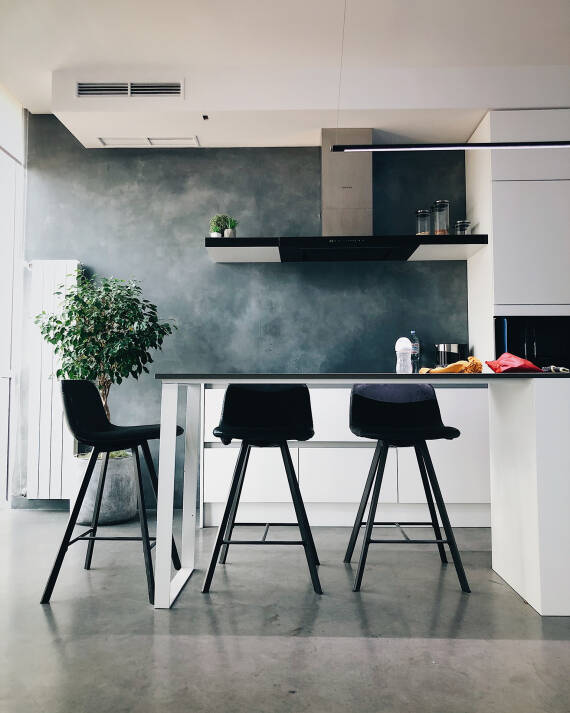A versatile and striking place to socialise
Kitchen counters as all-rounders: All you need to know about the talented counter bar
The kitchen is so much more than just a place to cook. It is a living room and it is also a space for social interactions and more, and it needs to be able to handle a wide range of user requirements. This is precisely why you need a kitchen with a counter. This sleek piece of furniture is aesthetically pleasing, the visual focus of the room and is highly communicative. When it comes to functionality, it’s a genuine all-rounder:

Streamlined furniture with many uses
Straightforward, stylish and large dining area for a quick breakfast or snack in between meals. Also suitable for larger gatherings
Extra worktop space when the main worktop is not enough while cooking
Stylish sideboard for when you need more room on the dining table or space for a buffet
Flexible temporary office, where you can quickly respond to a couple of e-mails or keep an eye on the children doing their homework while you cook
Practical shelf for all the important things you need throughout the day – from car keys to an apple from the fruit bowl
Perfect presentation space for fresh flowers or elegant décor
A place to meet, as the best chats always happen at the counter
Sophisticated design for the perfect look and functionality

When coming up with the design, looks aren’t the only aspect to consider. You also need to think about how you want to use the kitchen counter. The size and shape are just as important as the choice of materials here, as these factors will determine whether the overall look and functionality later meet your expectations.
The shape makes all the difference
A kitchen counter should be big enough for the user to make the most of it, while also fitting the space perfectly.
Table extensions add to the space on the worktop. A cooking island with a counter to extend it and with bar stools for seating is the perfect place to cook while you socialise. The stools can be simply pushed under the slab when not in use.
Depending on the layout of the room, a wall counter might be a sensible alternative. It doesn’t need to have the traditional 60-centimetre depth of a worktop. This adds to the flexibility if space is limited.
If you are designing an open-concept kitchen, the counter can also act as a partition and a connecting element between the cooking and living room/dining area.
Tabletops are nifty. They look like they have been simply placed on top of the worktop, making them a real head-turner.
So many options for materials
The burning question: Which material should you use for the counter? Do you want your kitchen to have a coherent look? Then use the same surface finish as your worktop. Or you could go for a contrast here. The key is it should fit in with the room’s overall concept. Either way, when it comes to choosing the material, bear in mind how you plan to use your kitchen counter.
Wood adds warmth to the room and has a natural look. However, it can also be quite susceptible to mould and other unwanted occurrences, especially if it is just oiled and not varnished.
Tempered glass is resistant to heat, cuts and scratches. It is also easy to clean, low maintenance and has an ultra-elegant look.
Natural stone is also hard-wearing and beautiful. However: whether you pick marble, granite or slate, natural stone surface finishes require regular care.
Concrete surface finishes are also highly durable but they need to be regularly sealed.
Engineered stone such as quartz or the Dekton compound combine the natural stone effect with high-tech material properties. It doesn’t get much tougher or more durable than this.
Practical features you won’t want to be without
Modern kitchen counters have quite a lot to offer when it comes to functionality. Including storage space. Open shelves offer support, break up the room’s look and beautifully showcase glasses, crockery and other utensils. You can store less decorative kitchen equipment in a supporting base cabinet.
You can have maximum flexibility with a height-adjustable counter, where you can sit and relax in your WFH office set-up or to have dinner. And if you invite people over, they can casually gather around it and socialise with a glass of wine.
Also extremely practical: Sliding counters. They save space and can be quickly pulled out if you need extra worktop space. Important: Don’t forget to incorporate USB ports and plenty of sockets into the design.
Frequently asked questions about kitchen counters
During the design phase, we recommend you take the planned use and the room’s overall look into consideration.
As a dining area, additional worktop, extension table, temporary office, shelf, presentation space and, of course, as a meeting place.
You have the choice between extension tables, wall counters, room dividers and table tops.
Depending on the planned use and visual appearance, wood, glass, natural stone, engineered stone and concrete are suitable.
Yes, lots! Storage space on the shelves and base cabinets, for one. You can also get height-adjustable, sliding counters. And there is also the option to install USB ports and plug sockets.
Sleek furniture that is also beautiful and highly functional
Kitchen counters are genuine all-rounders. When coming up with the design, it is important that you think about what you want to use it for. The size, shape, materials and functionality are all aspects you can play with here. Your kitchen counter is sure to become your new favourite place – for everyone.
Authorised dealers